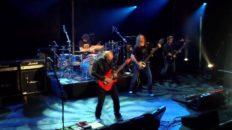Video Length: 3 minutes 48 seconds
Artist website: www.stevestevensguitar.com
Musicians
Steve Stevens – electric guitar & Ray Gun
What makes this video great and what can you learn from it?
- view into Steve’s home recording studio
- how Steve initially created the “Rebel Yell” effects
- how to “use” the Ray Gun
- what modifications Steve made to have more flexibility
What can you learn from the article?
- some background on Steve Stevens
- how to get the signature Stevens sound via a sample library
- ideas and suggestions for sound fx experimentation
Key Moments in “How to Create the Ray Gun Effect”
| topic | video timestamp |
|---|---|
| “Rebel Yell” – Lexicon PCM41 | 0:33-1:18 |
| How to hold the Ray Gun | 1:35-1:37, 3:32-3:42 |
| Ray Gun circuit bending | 2:04-2:14, 3:17-3:25 |
| Ray Gun sounds & demonstration | 2:17-3:07 |
| “Crossfading” to control the sound | 3:09-3:15 |
Most people put Steve Stevens into a single category – the flamboyant 80s hair-metal Glam/Rock player. They associate Steve with Billy Idol and maybe also have the latex-leather look of his appearance in Michael Jackson’s “Dirty Diana” video in mind.
But Steve did more than that. If having a 30+ year collaboration with Billy Idol and working with Michael Jackson on one’s CV is not enough, check out what else is on the list:
- winning a Grammy for the “Top Gun Anthem” that he co-wrote with Harold Faltermeyer
- recording/touring with Vince Neil
- working with Robert Palmer
- releasing the solo-albums “Atomic Playboys”, “Flamenco a Go-Go” & “Memory Crash”
- forming the super group “Bozzio Levin Stevens” and recording two albums with them
So he actually is quite versatile in different styles from Flamenco to Hard Rock, Pop, Progressive Rock to even Fusion.
Crazy Sound FX
One of his signature trademarks is his use of crazy sound effects. He makes his guitar sound like anything from helicopters to laser fx.
“I’ve got to ask you something: how do you do that weird kind of Ray Gun kind of bz bz?”
interviewer – 0:00-0:06 in the video on this pageFrom the “Rebel Yell” Lexicon PCM41 to a Ray Gun
Steve talks about the Lexicon PCM41 delay that they used for “Rebel Yell” in the studio. I just did a quick price check on those units from 1980. Currently they sell for ca. 600$, which is an o.k. price for almost vintage hardware. But don’t forget, you’d still have to do a lot of editing and tinkering to create those sounds.
A plastic toy definitely is the cheaper option. Circuit bending and messing with the potentiometers to change the rate of the effect is optional. I’m sure that just with a basic, unmodified Ray Gun lots of crazy sounds are possible.
So, to get the Ray Gun effect, use a Ray Gun – obvious, right?
And in case you do want to get your hands on a modified deluxe Ray Gun … Who would be more qualified than Steve himself? You can buy them directly from Steve in his online shop.
Steve Stevens Guitar Sample Library
Btw, if you are interested in adding the Steve Stevens sound to your music productions, have a look at the East West 25th Anniversary Collection that includes the Steve Stevens Guitar Sample library.
I would not buy it at the regular 49$ price, but in case EW does one of their frequent sales it might be worth it for a lower price. Just keep the age of the library in mind. You can’t compare it with a current multi-Gigabyte deep-sampled library. It’s more than 25 years old. But even though there are no round-robins and the size is rather small with ca. 500 Mb, the sound oozes Steve Stevens and especially the power chord recordings can still be useful, even today.
You’ll have to scroll down the list to find the Steve Stevens sound library. Then you can listen to an audio demo of the sounds in action and decide for yourself.
Conclusion
Experiment
There are quite a few options available to you to expand the guitar’s sonic landscape:
- the Ray Gun (obviously) 🙂
- power drills
- coins
- wrenches
- screwdrivers
- e-bows
- conventional bows
- drum sticks
- mallets
Experiment with some of those items I’ve just listed and see what crazy sounds you can come up with. But don’t do anything too stupid and hurt yourself, ok? 😉
Hint: check out the “gadget” tag. I’ll tag all videos that feature unusual guitar gadgets. This way, you can easily find those videos and check them out for inspiration.
Get notified whenever I publish a new article!
Absolutely NO Spam – Unsubscribe Anytime.







